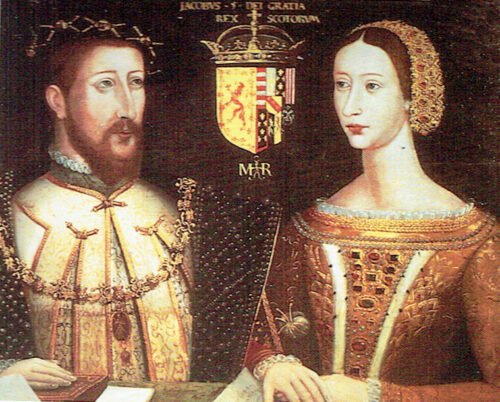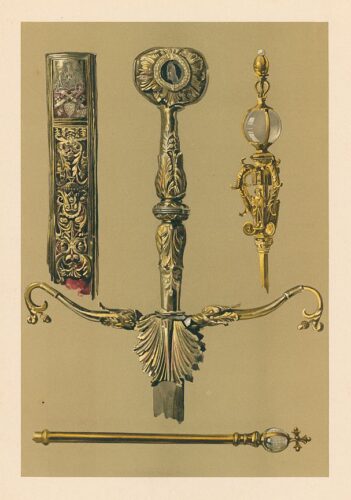
The Crown Jewels of Scotland that were presented to HM King Charles III, are the oldest surviving in the United Kingdom. The earliest piece dates from 1540. They consist of The Crown of Scotland, The Sword and The Sceptre.
The Crown was first worn by James V who wore it at the Coronation of his wife, Mary of Guise in 1540. In 1543, their daughter, Mary, Queen of Scots became the first Scottish monarch to be crowned with it and she was also the first to be crowned with the Sceptre which is believed to have been a gift to James IV by the Pope.
The last coronation in Scotland took place in 1651, when Charles II was crowned at Scone. Although done in haste, to thwart the invading Cromwellian army, the ceremony was done with the pomp and solemnity befitting the coronation of a king. After the ceremony, the Honours were secreted away to protect them from the invaders. This act alone kept them safe and they remained hidden during the period 1651-60.
After that time, while no longer used in Coronations, the regalia was taken to Parliament and put on display to signify the presence of the Sovereign, but after the Union of 1707 the Honours were locked away, and forgotten, until 1818, when they were re-discovered by the Castle Governor in the presence of Sir Walter Scott. Since that time, they have been exhibited in the Crown Room at Edinburgh Castle.
The Honours were last used in 1953 when they were presented to the late Queen Elizabeth.

The Crown of Scotland dates from 1540 and was first worn by James IV. It was re-fashioned by an Edinburgh goldsmith from an older and damaged crown, thought to have been made in the 14th century. The circlet is made of gold and encrusted with 22 gemstones and 20 precious stones, which were taken from the previous crown. The freshwater pearls used on the crown come from the rivers of Scotland.
Originally a gift from the Pope Alexander VI to James IV in 1494 to replace an earlier rod. Made in Italy of silver-gilt the sceptre was remodelled in 1536 when it was lengthened by an Edinburgh goldsmith. It is decorated with figures of the Virgin and Child on the finial, with images of St James and St Andrew under canopies and flanked by dolphins. A polished globe of rock crystal tops the sceptre.
In 1507, James IV received another papal gift, this time from Pope Julius II. The sword is 5 feet long with a steel blade of just over 3 feet in length. The silver-gilt handle is decorated with oak leaves and acorns, with two stylised oak leaves at the bottom of the handle overlapping the blade.
The blade is etched with an inscription Julius II Pont Max are inlaid in gold and figures of St Peter and St Paul.
The Scabbard is made of wood and covered in dark red velvet. It has a belt of woven silk and gold thread and decorated with the arms of Pope Julius.
This sword was regularly used in the ceremony of the Order of the Thistle until 1987.
The original sword is now so fragile that a new sword, the Elizabeth Sword, has replaced it. Named to honour the late Queen, it was commissioned in 2022 and designed by the former Ormond Pursuivant, Mark Dennis. This first time the sword were used was at the presentation of the Honours to HM King Charles III.
The pommel of the new sword features Lewisian gneiss rocks from the north west of Scotland and has a scabbard of Perthshire oak.

The Ceremony of the Presentation of The Honours took place on 5 July 2023, at 2.15pm at St Giles’ Cathedral in Edinburgh.
The day began with a People's Procession down the Royal Mile to the Cathedral, escorted by the The Royal Regiment of Scotland. The Honours were brought from Edinburgh Castle, by car, down the Royal Mile to the Cathedral, escorted by HM Body Guard for Scotland (Royal Company of Archers) and a guard of honour consisting of representatives from all three forces.
HM The King, HM Queen Camilla and TRH The Duke and Duchess of Rothesay left Holyroodhouse just after 2pm and arrived at the Cathedral soon after. The service of thanksgiving began at 2.15pm.
During the ceremony, the Honours were presented, one by one, to The King:
There was a ceremony of about an hour, with readings in Gaelic and English and a selection of musical pieces including traditional Scottish and specially commissioned music.
As the Royal procession returned to Holyroodhouse, there was a 21 gun salute from Edinburgh Castle and at about 3.45, the Red Arrows ended the day's events with a fly past.
Looks like you haven't made a choice yet.